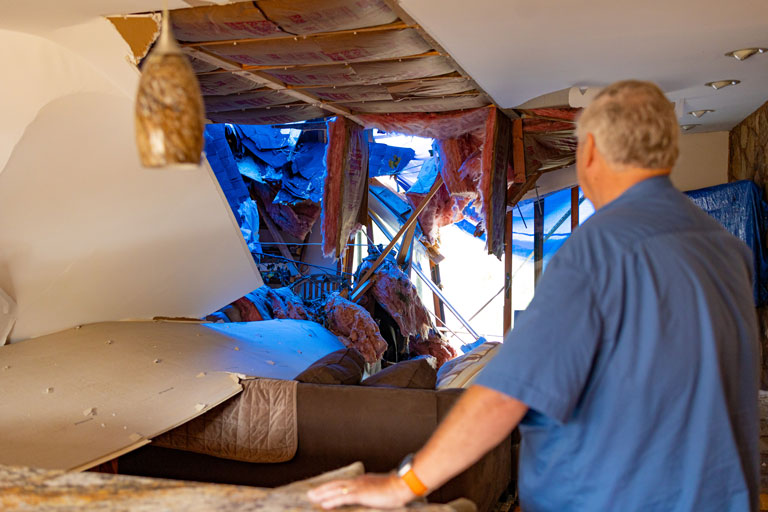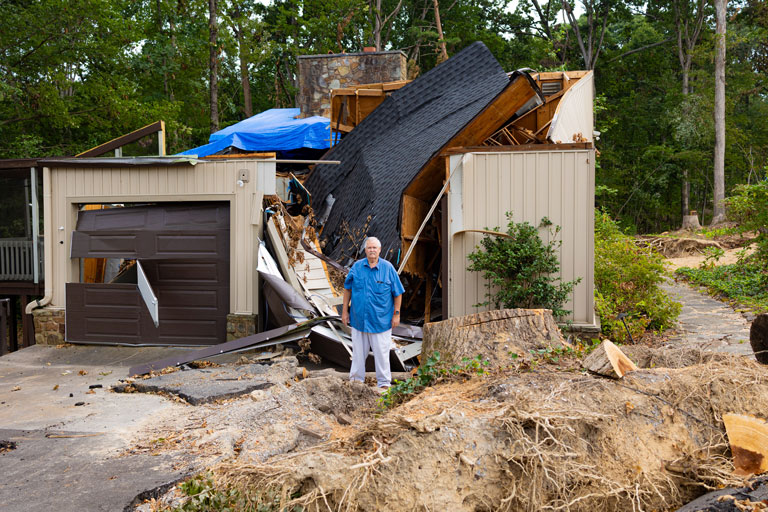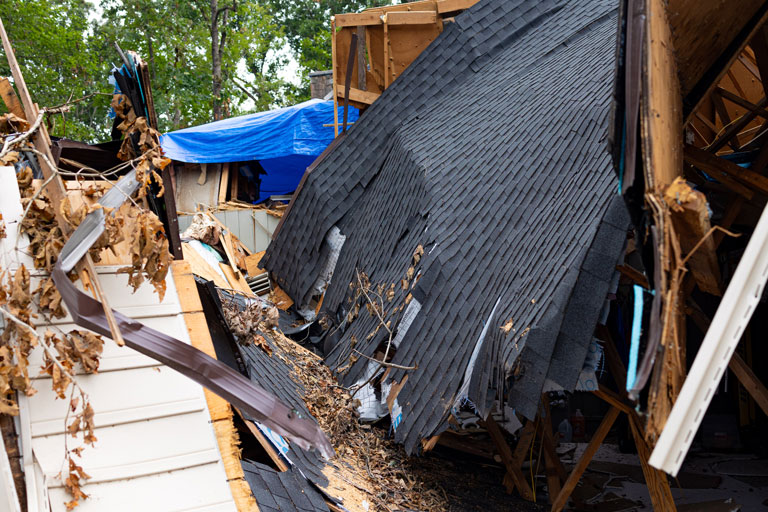By Amy Blakely. Photography by Shawn Poynter.
From studying the surprising way microbes have aided in the cleanup of major oil spills to monitoring campus wastewater for the COVID-19 virus, Terry Hazen has devoted his work life to studying stressed environments.
Hazen is the UT–Oak Ridge National Laboratory Governor’s Chair for Environmental Biotechnology. His resume includes stints working at three national laboratories and multiple universities as well as providing critical expertise in the wake of the Deepwater Horizon oil spill.
Earlier this month, Hazen―who jokingly calls himself “the poster boy for climate change” ―found himself in his own stressed environment: ground zero of a natural disaster.
Hazen’s 3,000-square-foot contemporary split-level home, nestled on three acres of mature hardwood trees on Night Hawk Lane near Bob Gray Road in West Knoxville, was heavily damaged by the EF2 tornado that hit west Knoxville on August 7. The house was crushed by eight trees toppled by the storm.
Climate Change, Microorganisms, and Methane
Much of Hazen’s research related to climate change has focused on microorganisms and methane. His doctoral dissertation looks at how fish and alligators were impacted by hot water discharged into a Savannah River nuclear reservation reservoir after cooling the reactor. The research provided insights into how rising water temperatures can impact wildlife.
“Because of the hot water, pathogens were increasing and outcompeting the normal bacteria and algae, and they were becoming dominant,” Hazen said. “Also, our research showed hot water was stressing fish and alligators and causing them to be more susceptible to disease.”
Years later, Hazen spent four months on the Gulf of Mexico studying the giant plumes of oil and gas that initially spread as a result of the 2010 Deepwater Horizon offshore drilling rig explosion.
Hazen reported that ocean-dwelling bacteria, including several previously unknown species, were quickly reducing the giant oil plumes. He also found that methane—which had contributed to the explosion and is considered a leading cause of climate change—was actually helping to degrade the oil. Those findings led scientists to begin studying new ways of fighting climate change.
More recently Hazen found similarly surprising results while studying the melting tundra in the Arctic.
“We thought methane was going to be released dramatically as the tundra increased in temperature,” he said. “While there is methane being released, it’s consumed almost completely and rapidly. We’re not seeing a lot of methane being released into the atmosphere.”
Now Hazen is assisting colleagues in the UT Institute of Agriculture who are studying the effects of climate change on food stocks and livestock. He’s also received funding to study the effects of wildfires, some of which are a result of climate change, on soil nutrients.
Hazen said he’s always been concerned with how climate change might lead to natural disasters, but now he feels that he’s experienced it firsthand.
“It doesn’t surprise me this tornado happened. It’s just a warning that we need to start doing something to ameliorate some of the effects of climate change,” he said.
Just as global warming is causing glaciers to melt and sea levels to rise, it’s causing the soil, air, and water to heat up.
While a definitive link between climate change and tornados remains unclear, the Center for Climate and Energy Solutions reports that “multiple studies find that the conditions that produce the most severe thunderstorms from which tornadoes may form are more likely as the world warms.”
SOS Call
The day of the storm, Hazen was working on the UT campus when his wife, Gayle, called him for help: their home had been badly damaged, and she was unable to get off the property.
News reports would later confirm that an EF2 tornado with wind gusts of 130 miles an hour had torn a 3.8-mile path through west Knoxville from Yarnell Road and North Campbell Station Road to Bob Gray Road and Middlebrook Pike.
“Being raised in Puerto Rico, Gayle was used to hurricanes,” Hazen said, explaining that she had taken the couple’s two Labrador retrievers and hunkered down in a walkin closet. “That saved her, because there was major damage to the rest of the house.”
When Gayle emerged from the closet, she found Hazen’s office, the TV room, and the kitchen in shambles. The power was out. Electrical wires in the house were exposed and hanging.
“A tree back by the garage had been lifted up by the roots, and it completely crushed the garage,” Hazen said. Inside, Gayle’s car was smashed.
To make matters worse, a large uprooted tree blocked the front door, and the road leading to the house was impassable because of fallen trees.
It doesn’t surprise me this tornado happened. It’s just a warning that we need to start doing something to ameliorate some of the effects of climate change.”
Hazen rushed home but couldn’t get close to the house. With the help of a friend, he spent more than two hours cutting a path through the woods to the house to free Gayle and the dogs.
Hazen said American Red Cross workers later said their home had some of the worst damage they’d seen after visiting more than 700 homes hit by the tornado.
Compounding the Damage
Although the storm hit on a Monday, Hazen couldn’t get a crane to lift the trees off the house’s roof until Saturday. Tarps didn’t arrive until Sunday.
By then it had rained again, compounding the damage.
Hazen said his insurance company will probably total Gayle’s car once it can be removed from the garage; insurance is still working on an estimate for the house. Meanwhile, he has arranged for an engineer to evaluate the structural integrity of the house before deciding what can be repaired and what must be rebuilt.
While the Hazens have salvaged some of their belongings from the house, a lot was lost—including mementos they had collected from China, Europe, Australia, the Caribbean, and other places they visited.
For now, the couple has relocated to their cottage at Watts Barr Lake. It’s about 50 miles from campus so it makes for a long commute, said Hazen, who splits his time between UT and ORNL.
Although his home office was destroyed, Hazen’s research data―collected during his four decades of work—is safe.
“I’ve always been paranoid about my data, so I have backups at ORNL, UT, and at home. And I carry a laptop with me.”




